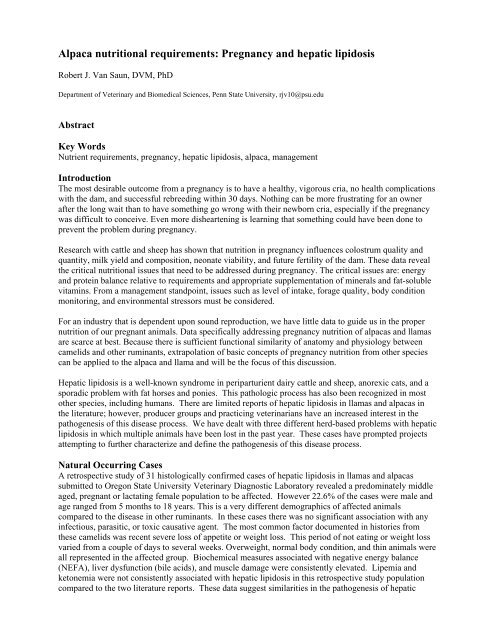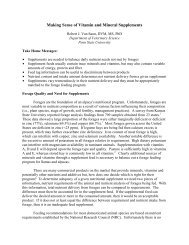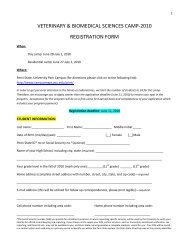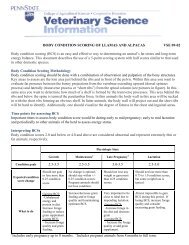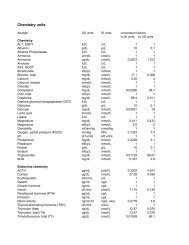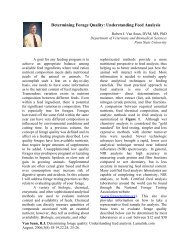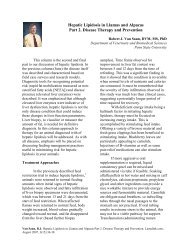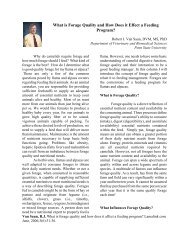Hepatic Lipidosis in Camelids - Veterinary and Biomedical Sciences
Hepatic Lipidosis in Camelids - Veterinary and Biomedical Sciences
Hepatic Lipidosis in Camelids - Veterinary and Biomedical Sciences
You also want an ePaper? Increase the reach of your titles
YUMPU automatically turns print PDFs into web optimized ePapers that Google loves.
Alpaca nutritional requirements: Pregnancy <strong>and</strong> hepatic lipidosis<br />
Robert J. Van Saun, DVM, PhD<br />
Department of Veter<strong>in</strong>ary <strong>and</strong> <strong>Biomedical</strong> <strong>Sciences</strong>, Penn State University, rjv10@psu.edu<br />
Abstract<br />
Key Words<br />
Nutrient requirements, pregnancy, hepatic lipidosis, alpaca, management<br />
Introduction<br />
The most desirable outcome from a pregnancy is to have a healthy, vigorous cria, no health complications<br />
with the dam, <strong>and</strong> successful rebreed<strong>in</strong>g with<strong>in</strong> 30 days. Noth<strong>in</strong>g can be more frustrat<strong>in</strong>g for an owner<br />
after the long wait than to have someth<strong>in</strong>g go wrong with their newborn cria, especially if the pregnancy<br />
was difficult to conceive. Even more dishearten<strong>in</strong>g is learn<strong>in</strong>g that someth<strong>in</strong>g could have been done to<br />
prevent the problem dur<strong>in</strong>g pregnancy.<br />
Research with cattle <strong>and</strong> sheep has shown that nutrition <strong>in</strong> pregnancy <strong>in</strong>fluences colostrum quality <strong>and</strong><br />
quantity, milk yield <strong>and</strong> composition, neonate viability, <strong>and</strong> future fertility of the dam. These data reveal<br />
the critical nutritional issues that need to be addressed dur<strong>in</strong>g pregnancy. The critical issues are: energy<br />
<strong>and</strong> prote<strong>in</strong> balance relative to requirements <strong>and</strong> appropriate supplementation of m<strong>in</strong>erals <strong>and</strong> fat-soluble<br />
vitam<strong>in</strong>s. From a management st<strong>and</strong>po<strong>in</strong>t, issues such as level of <strong>in</strong>take, forage quality, body condition<br />
monitor<strong>in</strong>g, <strong>and</strong> environmental stressors must be considered.<br />
For an <strong>in</strong>dustry that is dependent upon sound reproduction, we have little data to guide us <strong>in</strong> the proper<br />
nutrition of our pregnant animals. Data specifically address<strong>in</strong>g pregnancy nutrition of alpacas <strong>and</strong> llamas<br />
are scarce at best. Because there is sufficient functional similarity of anatomy <strong>and</strong> physiology between<br />
camelids <strong>and</strong> other rum<strong>in</strong>ants, extrapolation of basic concepts of pregnancy nutrition from other species<br />
can be applied to the alpaca <strong>and</strong> llama <strong>and</strong> will be the focus of this discussion.<br />
<strong>Hepatic</strong> lipidosis is a well-known syndrome <strong>in</strong> periparturient dairy cattle <strong>and</strong> sheep, anorexic cats, <strong>and</strong> a<br />
sporadic problem with fat horses <strong>and</strong> ponies. This pathologic process has also been recognized <strong>in</strong> most<br />
other species, <strong>in</strong>clud<strong>in</strong>g humans. There are limited reports of hepatic lipidosis <strong>in</strong> llamas <strong>and</strong> alpacas <strong>in</strong><br />
the literature; however, producer groups <strong>and</strong> practic<strong>in</strong>g veter<strong>in</strong>arians have an <strong>in</strong>creased <strong>in</strong>terest <strong>in</strong> the<br />
pathogenesis of this disease process. We have dealt with three different herd-based problems with hepatic<br />
lipidosis <strong>in</strong> which multiple animals have been lost <strong>in</strong> the past year. These cases have prompted projects<br />
attempt<strong>in</strong>g to further characterize <strong>and</strong> def<strong>in</strong>e the pathogenesis of this disease process.<br />
Natural Occurr<strong>in</strong>g Cases<br />
A retrospective study of 31 histologically confirmed cases of hepatic lipidosis <strong>in</strong> llamas <strong>and</strong> alpacas<br />
submitted to Oregon State University Veter<strong>in</strong>ary Diagnostic Laboratory revealed a predom<strong>in</strong>ately middle<br />
aged, pregnant or lactat<strong>in</strong>g female population to be affected. However 22.6% of the cases were male <strong>and</strong><br />
age ranged from 5 months to 18 years. This is a very different demographics of affected animals<br />
compared to the disease <strong>in</strong> other rum<strong>in</strong>ants. In these cases there was no significant association with any<br />
<strong>in</strong>fectious, parasitic, or toxic causative agent. The most common factor documented <strong>in</strong> histories from<br />
these camelids was recent severe loss of appetite or weight loss. This period of not eat<strong>in</strong>g or weight loss<br />
varied from a couple of days to several weeks. Overweight, normal body condition, <strong>and</strong> th<strong>in</strong> animals were<br />
all represented <strong>in</strong> the affected group. Biochemical measures associated with negative energy balance<br />
(NEFA), liver dysfunction (bile acids), <strong>and</strong> muscle damage were consistently elevated. Lipemia <strong>and</strong><br />
ketonemia were not consistently associated with hepatic lipidosis <strong>in</strong> this retrospective study population<br />
compared to the two literature reports. These data suggest similarities <strong>in</strong> the pathogenesis of hepatic
lipidosis <strong>in</strong> camelids to other species <strong>and</strong> not just rum<strong>in</strong>ants. A common theme <strong>in</strong> most cases of hepatic<br />
lipidosis <strong>in</strong> camelids is a period of anorexia prior to cl<strong>in</strong>ical signs.<br />
Based on this study <strong>and</strong> on additional cases identified s<strong>in</strong>ce it was completed, our conclusions are<br />
that camelids of a variety of ages, gender, body condition, <strong>and</strong> reproductive status are susceptible to<br />
development of hepatic lipidosis. Conditions that place <strong>in</strong>creased energy dem<strong>and</strong>s, such as pregnancy<br />
<strong>and</strong> lactation contribute to hepatic lipidosis, but other stresses <strong>in</strong>clud<strong>in</strong>g social <strong>and</strong> environmental stresses<br />
or other illness appear to also predispose camelids to loss of appetite, weight, <strong>and</strong> accumulation of fat <strong>in</strong><br />
the liver.<br />
Experimentally Induced <strong>Hepatic</strong> <strong>Lipidosis</strong><br />
S<strong>in</strong>ce a history of recent anorexia or weight loss was the most common factor <strong>in</strong> the naturally<br />
occurr<strong>in</strong>g cases of camelid hepatic lipidosis, we attempted to create a model of this condition by limited<br />
feed restriction. The study has <strong>in</strong>cluded lactat<strong>in</strong>g <strong>and</strong> non-lactat<strong>in</strong>g animals. After obta<strong>in</strong><strong>in</strong>g basel<strong>in</strong>e<br />
<strong>in</strong>formation, the llamas were weighed daily, fed a measured amount of hay, <strong>and</strong> given unrestricted access<br />
to water. Crias were allowed to nurse. Blood samples <strong>and</strong> liver biopsies were obta<strong>in</strong>ed throughout the<br />
study. The trial ended when there was any <strong>in</strong>dication <strong>in</strong> blood work, biopsy, or cl<strong>in</strong>ical signs of the onset<br />
of hepatic lipidosis.<br />
All llamas <strong>in</strong> the study lost large amounts of body weight. About half developed hepatic lipidosis.<br />
No animals became depressed or recumbent. Blood tests showed the expected <strong>in</strong>creases <strong>in</strong> liver enzymes<br />
<strong>in</strong> those that developed hepatic lipidosis, but not <strong>in</strong> those that simply lost weight. This is important <strong>in</strong><br />
tell<strong>in</strong>g us that our blood <strong>in</strong>dicators of liver disease (bile acids) are relatively specific <strong>in</strong> llamas. When the<br />
affected llamas were returned to normal feed, we saw <strong>in</strong>creases <strong>in</strong> weight, gradual changes <strong>in</strong> the blood<br />
values towards normal, <strong>and</strong> the disappearance of fat from the livers based on biopsies. This was also a<br />
significant f<strong>in</strong>d<strong>in</strong>g <strong>in</strong> that it showed that the condition is reversible when normal levels of nutrients <strong>and</strong><br />
calories are consumed.<br />
This study has shown that it is difficult, but possible to <strong>in</strong>duce hepatic lipidosis <strong>in</strong> llamas by feed<br />
restriction, which suggests that loss of appetite alone may not be enough to cause this problem. It has<br />
also shown that there are cl<strong>in</strong>ical <strong>and</strong> biochemical differences <strong>in</strong> this experimental model of hepatic<br />
lipidosis <strong>and</strong> the naturally-occurr<strong>in</strong>g form. We are speculat<strong>in</strong>g that the additional stresses <strong>in</strong>volved <strong>in</strong><br />
most of the naturally-occurr<strong>in</strong>g cases lead to changes <strong>in</strong> how the animals can utilize carbohydrates,<br />
prote<strong>in</strong>s, <strong>and</strong> lipids. We plan to study factors that might be <strong>in</strong>volved.<br />
Conclusions<br />
The key to prevent<strong>in</strong>g <strong>and</strong> treat<strong>in</strong>g this disease is <strong>in</strong>creased underst<strong>and</strong><strong>in</strong>g of the unique metabolic<br />
processes of camelids. The bottom l<strong>in</strong>e for prevention is to ensure adequate energy <strong>and</strong> prote<strong>in</strong> <strong>in</strong>take,<br />
especially <strong>in</strong> pregnant <strong>and</strong> lactat<strong>in</strong>g females through good quality forage <strong>and</strong> appropriate<br />
supplementation. Adequate energy/prote<strong>in</strong> <strong>in</strong>take can be easily assessed by use of h<strong>and</strong>s-on body<br />
condition scor<strong>in</strong>g. Close monitor<strong>in</strong>g of <strong>in</strong>take <strong>in</strong> sick animals is absolutely critical to prevent deaths.<br />
References:<br />
Tornquist, SJ, Cebra, CK, Van Saun, RJ, Smith, BB. Metabolic changes <strong>and</strong> <strong>in</strong>duction of hepatic lipidosis<br />
dur<strong>in</strong>g feed restriction <strong>in</strong> llamas. American Journal Veter<strong>in</strong>ary Research 2001;62(7):1081-<br />
1087.<br />
Van Saun, RJ. Callihan, B, Tornquist, SJ. Nutritional support for treatment of hepatic lipidosis <strong>in</strong> a llama.<br />
Journal Am Veter<strong>in</strong>ary Med Assoc 2000;217(10):1531-1535.
Tornquist, S.J., R.J. Van Saun, B.B. Smith, C.K. Cebra <strong>and</strong> S.P. Snyder. Histologically-confirmed<br />
hepatic lipidosis <strong>in</strong> llamas <strong>and</strong> alpacas: 31 Cases (1991-1997). Journal Am Veter<strong>in</strong>ary Med<br />
Assoc 1999;214(9):1368-1372.


